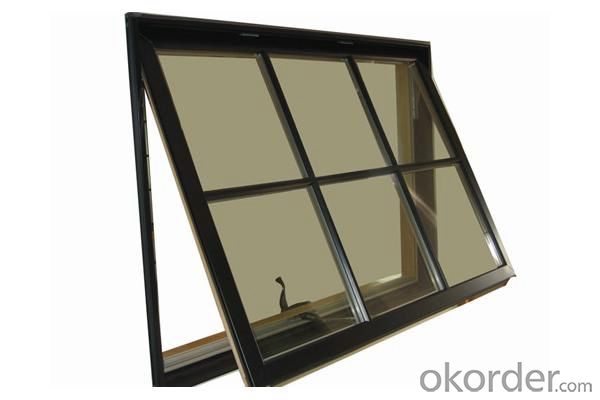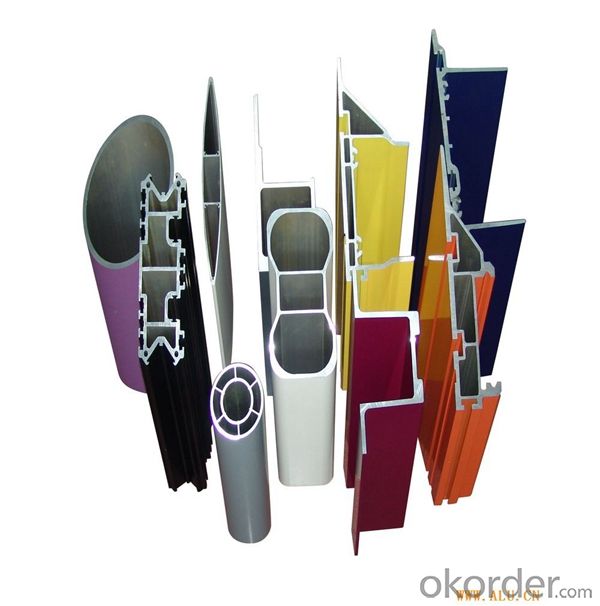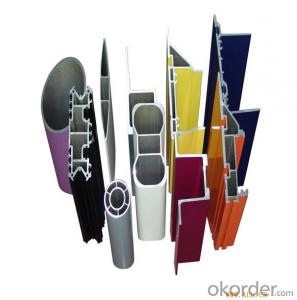Aluminum Extrusion Profile for Curtain Wall Made in China
- Loading Port:
- Shanghai
- Payment Terms:
- TT OR LC
- Min Order Qty:
- 5 m.t.
- Supply Capability:
- 1000 m.t./month
OKorder Service Pledge
OKorder Financial Service
You Might Also Like
Item specifice
1. Specification of Aluminum Extrusion Profile for Curtain Wall Made in China
Alloy | State | Tensile Strength δbMpa | Non-proportional Stretching Stress(δp0.2Mpa) | Stretching rate (δ%) | Pattern Thickness (mm) | HV | HW |
No Less Than | |||||||
6061 | T4/T6 | 180/265 | 110/245 | 16/8 | - | - | - |
6063 | T5/T6 | 160/205 | 110/180 | 8/8 | 0.8/- | 58/- | 8/- |
6063A | T5/T6 | 200,190/230,220 | 160,150/190,180 | 5,5/5,4 | 0.8,0.8/-,- | 65,65/-,- | 10,10/-,- |
2. Application of Aluminum Extrusion Profile for Curtain Wall Made in China
wall cladding, ceilings, bathrooms, kitchens and balconies, shutters, doors,windows…
3. Feature of Aluminum Extrusion Profile for Curtain Wall Made in China
Surface Quality :
Be free from Oil Stain, Dent, Inclusion, Scratches, Stain, Oxide Decoration, Breaks, Corrosion, Roll Marks, Dirt Streaks and other defect which will interfere with use,
Mochenical Property:
Chemical Composite and Mechanical Property
4. Certificate:
SGS and ROHS(if client request, paid by client), MTC(plant provided), Certificate of Origin(FORM A, FORM E, CO), Bureau Veritas and SGS (if client request, paid by client), CIQS certificate
5. Image of Aluminum Extrusion Profile for Curtain Wall Made in China



6. Package and shipping of Aluminum Extrusion Profile for Curtain Wall Made in China
First, plastic cloth with drying agent inside; Second, Pearl Wool; Third, wooden cases with dry agent, fumigation wooden pallets, aluminum surface could cover blue PVC film
7. FAQ
Question 1: What is your MOQ?
We accept one ton per type for an order. But the detail we could negotiate.
Question 2: What is your normal terms of payment?
We always trade with you by T/T. But we also accept the L/C as you require.
Question 3: How many kinds of the surface treatment we can choose?
You could choose different color of powder coated. Anodized of black. matte silver, nature, champagne, bronze color. Mill finished. Wooden finished and printed.etc.
Question 4: Can you supply OEM services?
We offer OEM services for 17 years.
Question 5: How many days for opening the mould?
Normally about 10 days.According to the difficulty of your drawing.
Question 6: Can i choose the package what i want?
Yes, of course. We offer various kinds of package.e.g.PE foam. Shrink film. Wrapping paper.
But we would give you professional suggestion of package.
- Q:Are aluminum profiles resistant to impact or vibration?
- Yes, aluminum profiles are generally resistant to both impact and vibration. Aluminum is known for its high strength-to-weight ratio and excellent durability. It can withstand external forces and impacts without easily deforming or breaking. Additionally, aluminum's natural properties make it inherently resistant to vibration. It has a high damping capacity, meaning it can absorb and dissipate vibrations, reducing their effects. This makes aluminum profiles an ideal choice for applications where impact or vibration resistance is required, such as in the construction, automotive, aerospace, and marine industries.
- Q:Are aluminum profiles suitable for use in medical device manufacturing?
- Yes, aluminum profiles are suitable for use in medical device manufacturing. Aluminum is a lightweight and durable material that offers excellent mechanical properties, corrosion resistance, and versatility. It can be easily machined and formed into various shapes, making it ideal for creating custom components for medical devices. Additionally, aluminum profiles can be anodized or coated to further enhance their surface properties, ensuring compatibility with medical environments.
- Q:How about the price of aluminum profile?
- Usually calculated by weight, or by weight according to the length of each metre.
- Q:Can aluminum profiles be painted or coated?
- Yes, aluminum profiles can be painted or coated.
- Q:What are the different surface etching options for aluminum profiles?
- Some different surface etching options for aluminum profiles include chemical etching, mechanical etching, and laser etching. Chemical etching involves using a chemical solution to remove layers of the aluminum surface, creating a desired pattern or texture. Mechanical etching involves using abrasive materials or tools to physically remove material from the surface. Laser etching uses a laser beam to selectively remove material from the surface, creating precise and intricate designs.
- Q:How do aluminum profiles perform in wind-resistant structures?
- The performance of aluminum profiles in wind-resistant structures is widely recognized. They possess inherent strength and durability, enabling them to endure high wind pressures while maintaining their structural integrity. The lightweight characteristic of aluminum makes it an ideal material for wind-resistant structures as it reduces the overall building load without compromising strength. Aluminum profiles exhibit high tensile strength and resistance to corrosion, making them suitable for harsh weather conditions, including strong winds. They also possess a high stiffness-to-weight ratio, which effectively distributes wind load and minimizes deflection. This characteristic is crucial in wind-resistant structures as it prevents excessive movement and ensures the safety of the building and its occupants. Moreover, aluminum profiles offer easy fabrication and customization, allowing for the creation of intricate and innovative designs. This design flexibility empowers architects and engineers to optimize the structure's aerodynamics, further enhancing its resistance to wind forces. Additionally, aluminum profiles can be combined with other materials, such as glass or composite panels, to establish a more robust and efficient wind-resistant system. In conclusion, aluminum profiles are incredibly reliable and efficient for wind-resistant structures. Their strength, lightweight nature, corrosion resistance, and design flexibility make them an exceptional choice for constructing buildings that can endure strong winds and guarantee the safety and durability of the structure.
- Q:How do you join two aluminum profiles together?
- To achieve the desired strength, appearance, and functionality of a joint between two aluminum profiles, there are multiple techniques available. Here are a few commonly employed methods: 1. Utilizing Mechanical Fasteners: One straightforward and widely used approach is to employ mechanical fasteners like screws, bolts, or rivets. These fasteners can be drilled through both profiles and tightened to securely connect them. The selection of the appropriate size and type of fastener should be based on the profiles' thickness and material. 2. Employing Welding: Welding is another popular means of joining aluminum profiles. It involves melting the aluminum at the joint and allowing it to solidify, creating a strong bond between the profiles. Different welding techniques, such as TIG (Tungsten Inert Gas) welding and MIG (Metal Inert Gas) welding, can be utilized depending on the specific application and requirements. 3. Implementing Adhesives: Adhesive bonding provides a non-intrusive method for connecting aluminum profiles. Specially formulated adhesives designed for aluminum bonding can be applied to the profile surfaces and then pressed together. This type of joint is particularly advantageous when a seamless appearance is desired, as it eliminates the need for visible fasteners or welds. However, the strength of the adhesive bond may vary depending on the adhesive type. 4. Employing Interlocking Systems: Certain aluminum profiles are designed with interlocking systems that allow for easy connection. These systems typically involve the use of connectors or accessories specifically designed for the given profiles. They can deliver a secure and sturdy joint while also simplifying the assembly process. When choosing the appropriate method to join two aluminum profiles, it is vital to consider factors such as strength requirements, aesthetics, ease of assembly, and the potential need for disassembly. Additionally, consulting professionals or experts in aluminum fabrication is recommended to ensure the chosen method suits the specific application.
- Q:Can aluminum profiles be used in material handling equipment manufacturing?
- Yes, aluminum profiles can be used in material handling equipment manufacturing. Aluminum profiles are lightweight, corrosion-resistant, and have high strength-to-weight ratio, making them ideal for constructing various components of material handling equipment. These profiles can be easily customized and assembled to create frames, support structures, conveyor systems, and other parts of material handling equipment. Additionally, aluminum profiles offer flexibility in design, allowing for easy modifications or additions to the equipment as per specific requirements.
- Q:Are aluminum profiles suitable for use in automotive body structures?
- Yes, aluminum profiles are suitable for use in automotive body structures. Aluminum is a lightweight and durable material that offers several advantages in the automotive industry. Its high strength-to-weight ratio makes it an ideal choice for constructing body frames, panels, and other structural components. Using aluminum profiles in automotive body structures offers benefits such as improved fuel efficiency, as the lighter weight of the material reduces the overall weight of the vehicle. This, in turn, allows for better acceleration and handling. Additionally, aluminum possesses excellent corrosion resistance, which is crucial for withstanding harsh environmental conditions and extending the lifespan of the vehicle. Furthermore, aluminum profiles can be easily shaped and formed into complex designs, allowing for greater design flexibility in automotive body structures. This versatility enables manufacturers to create more aerodynamic and visually appealing vehicles. While aluminum profiles offer numerous advantages, there are also some considerations to be aware of. Aluminum can be more expensive than traditional steel, which may impact the overall cost of the vehicle. Additionally, the repair and maintenance of aluminum structures may require specialized equipment and expertise. However, these factors are outweighed by the benefits aluminum profiles bring to the automotive industry. In conclusion, aluminum profiles are indeed suitable for use in automotive body structures. Their lightweight, durable, and corrosion-resistant properties, along with their design flexibility, make them an excellent choice for constructing modern vehicles.
- Q:Can aluminum profiles be used in noise insulation applications?
- Yes, aluminum profiles can be used in noise insulation applications. Aluminum profiles are versatile and can be designed to have excellent acoustic properties. They can be used to create soundproof windows, doors, walls, and enclosures. Aluminum profiles can be combined with materials like acoustic glass, rubber seals, and insulation foam to enhance their noise insulation capabilities. Additionally, aluminum's inherent strength and durability make it suitable for use in noise insulation applications as it can withstand the pressure and vibrations caused by sound waves. Overall, aluminum profiles offer a viable solution for noise insulation requirements in various settings, including residential, commercial, and industrial buildings.
1. Manufacturer Overview |
|
|---|---|
| Location | |
| Year Established | |
| Annual Output Value | |
| Main Markets | |
| Company Certifications | |
2. Manufacturer Certificates |
|
|---|---|
| a) Certification Name | |
| Range | |
| Reference | |
| Validity Period | |
3. Manufacturer Capability |
|
|---|---|
| a)Trade Capacity | |
| Nearest Port | |
| Export Percentage | |
| No.of Employees in Trade Department | |
| Language Spoken: | |
| b)Factory Information | |
| Factory Size: | |
| No. of Production Lines | |
| Contract Manufacturing | |
| Product Price Range | |
Send your message to us
Aluminum Extrusion Profile for Curtain Wall Made in China
- Loading Port:
- Shanghai
- Payment Terms:
- TT OR LC
- Min Order Qty:
- 5 m.t.
- Supply Capability:
- 1000 m.t./month
OKorder Service Pledge
OKorder Financial Service
Similar products
New products
Hot products
Hot Searches
Related keywords





























